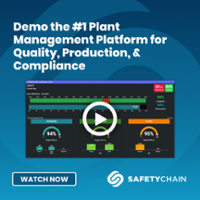Continuous Improvement in Process Manufacturing | Understanding, Measuring and Improving OEE
Manufacturing facilities, rely on OEE—overall equipment effectiveness—as the single best metric for identifying losses and benchmarking progress towards improving the performance of their equipment. Measuring OEE helps managers determine the percentage of manufacturing time that is genuinely productive.
Correctly measuring overall equipment effectiveness OEE in a manufacturing facility delivers several key benefits. By adding sensors to capture run, down, and cycle times, OEE allows facilities to increase production line availability, performance, and quality. The focus of this article is to understand why measuring OEE is so valuable in particular.
Meeting the Demands of Modern Manufacturing
Decades ago, manufacturers would perfect static processes, often running lines for several months at a time without introducing any new variables. Today, however, products have become more diverse by leaps and bounds. Many manufacturers have adjusted their production accordingly, implementing continuous changes to meet the evolving demands for unique products and flavors. As a result, manufacturers need more profound insights into their production lines than ever before, and changeovers must be streamlined to optimize availability, performance, and quality across every batch.
The beauty in applying OEE to an increasingly complex manufacturing landscape is that the concept and application of OEE for process manufacturing are fundamentally simple. In fact, because there are only three working parts in OEE—time, quality, and speed.
What is OEE in TPM?
In 1982, Seiichi Nakajima, the Japanese father of TPM, first explicitly described OEE. The concept of TPM, or total productive maintenance, began as a method of focusing on factory machinery improvement and maintenance to drive down costs. Nakajima developed TPM from the 1950s to the 1970s, but it took time for TPM to spread as a commonly employed methodology outside of Japan.
As TPM evolved, OEE emerged as the primary target outcome. TPM functionally drives toward constant OEE by using a focused tactic designed to minimize each type of OEE loss.
When Nakajima first described OEE as the focal outcome of TPM, he originally defined the second ‘E’ as efficiency. Over time, the subtle yet meaningful shift from efficiency to effectiveness has signified the transition to quantifying the degree of success.
As TPM moved beyond Japanese factories and spread, so did the concept of OEE. In the 1990s, the semiconductor component industry applied OEE measurements with great success. By the end of the 1990s, Arno Koch was developing standards that would facilitate the expansion of OEE for process manufacturing in various situations. Many Western production facilities by the early 2000s began to access and productively apply OEE. Now, OEE fits perfectly with the increasing reliance on automation in manufacturing.
Where Does OEE Software Come In?
While the practices of decades past, including lean manufacturing, led manufacturers through the 1970s and the following decades, the digital age has introduced opportunities for more effective monitoring of key performance indicators (KPIs). Past methodologies typically honed in on a single machine or process and looked at historical trends to track improvement.
Plus, most plants only measured one or two attributes of OEE like weight in pounds or cases per hour and overall downtime. Nothing was calculated for loss of product (Quality) or holistically calculated for an entire line or whole plant.
OEE software now combines sensor data and automated data collection to track performance in real-time across many different machines. By unlocking insights into what’s going on with production lines, OEE software gives manufacturers the power to see what is happening in real-time—and thus improve—their systems. Some OEE software solutions go as far as to provide an overview dashboard where visibility across the plant is now at the tip of your fingers.
How Can OEE be Improved in Manufacturing | Four Best Practices
1.) Tracking Critical Performance Metrics
Tracking just a few KPIs with manual processes is a significant challenge for manufacturers. By introducing OEE software, managers can consistently measure their plant’s most important metric, thereby uncovering where performance is excelling, lagging, or simply staying consistent. But for the plant with several lines, and the need to get insight at the batch level, point solutions will fail miserably. OEE should include these particular scenarios. While the KPIs you choose to track should depend on your specific needs, goals, and company strategy, here are a few of the most essential KPI analytics for manufacturers to assess:
Performance: actual production speed versus optimal production speed
Availability: actual run time versus total operational time
Quality: good products versus total product output
Yield: number of suitable units versus those that need rework
By consistently collecting and analyzing data from all of your sensors, OEE software enables you to track these KPIs as well as any others. OEE itself can even be used as a KPI, offering a comprehensive overview of a plant’s effectiveness by consolidating quality, performance, and availability metrics into one formula, especially when comparing across multiple facilities in a company or business unit.
Additionally, as automation becomes more ubiquitous, demonstrable metrics in OEE manufacturing deliver the notifications that managers need with fewer human eyes on the production floor. And even in situations where there’s a higher level of visual oversight, the metrics that a detailed OEE software can provide grants a much fuller, richer perspective of trends in relation to goals.
2.) Adjusting in Real-Time
Though adjusting in real-time is critical for all manufacturers, food manufacturers face unique constraints. It’s not always practical or possible to rework materials, and factors such as expiration dates make the need for timely resolutions especially important when there are roadblocks. Real-time views of a line are therefore necessary for prompt corrective actions on the batches currently in production. It also reduces the risk of a substantial raw material dump. Let’s face it—some products cannot be reworked.
OEE software is undeniably valuable because it doesn’t just provide you with the data you need to make better decisions; it can also alert you of issues happening in the moment so you can react quickly and mitigate the impact that potential problems could have on your production. The results are smoother, more quality-driven operations, reduced rework, more on-time shipments, and increased customer satisfaction. Speed of response converts directly to mitigation of loss and allows production to pivot competitively with less waste.
3.) Increasing Equipment Performance
In addition to improving overall plant performance, OEE software can also help you pinpoint any snags in your process, including equipment failures. With a direct line of sight into sensor data, you can spot inefficiencies caused by issues such as frequent breakdowns of a single machine or component, which could cause downstream issues leading to a significant impact online performance. Using data to schedule downtime for routine maintenance and checks effectively is much more efficient than having downtime with machine breaks. OEE data—when adequately visualized by graphs and charts—can help achieve this. For examples of what this visualization looks like, check out the Production Manager Solution from SafetyChain.
4.) Improving Continuously & Instilling Constructive Competition
Finally, OEE helps manufacturers improve consistently. Here are just a few of the benefits companies see in their plants by leveraging OEE data:
Improved productivity: With insights into trends across shifts, lines, and equipment, OEE manufacturing software allows you to make meaningful changes that can drive the performance of both your employees and machines. Manufacturers can then make more accurate forecasts.
Better quality: Tackle quality issues by identifying the problems which could lead to rework and non-conforming material.
Accelerated throughput: Identify and address interruptions in your processes with OEE software’s intuitive reporting features. Use your findings to eliminate repetitive or wasteful work and drive throughput.
Higher yield: Use OEE software’s root cause analysis and alerts to dive deeper into issues affecting yield.
Reduced costs: With the ability to improve performance, reduce waste and rework, and accelerate production, watch as your plant’s overall costs decrease.
Healthy competition: drive better continuous OEE improvements with our nature to compete and outperform. This can be done by looking at a percentage improvement over baseline OR head-to-head comparisons with other facilities. Think about how you can run competitions between lines or facilities!
Whether you have one plant with a single line, you’re a corporate controller looking at all-important lines in financial statements, or your CoMan or CoPack operations need a better way to serve customers, it’s worth taking a closer look into software that proactively corrals OEE for process manufacturing. Shaking down complex systems and generating clearly defined OEE percentages can be a valuable tool for driving compliance throughout the entire team, not just management.




